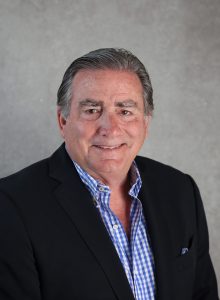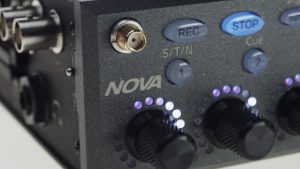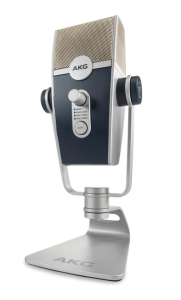The AES Show: More New Hardware Than in Recent Years
Virtual networks and streaming were a focus for many exhibitors
Story Highlights
The phrase “What’s new?” has been superseded on trade-show floors in recent years by “What have you seen the latest software version of?” However, at Audio Engineering Society’s AES Show at New York’s Javits Center last week, there was a wealth of new products.
A major example was right at the front of the audio hall, adjacent to the hall occupied by the NAB Show New York: Solid State Logic was showing its first new fully analog audio console in 25 years. The ORIGIN analog desk harks back to the traditional in-line console designs of the 1970s and ’80s, such as SSL’s famous 4000 series. ORIGIN evokes and emulates the 4000 series in many ways, with a dual-channel design, 16 buses, E Series EQ, and the company’s classic Bus Compressor. Not a broadcast console per se, but, given music’s deepening integration with sports on television, online, and in the venue, ORIGIN’s audio will likely turn up on-air soon.
In a related move, SSL’s parent company, UK-based Audiotonix — which also owns leading broadcast-audio–console manufacturer Calrec, live-sound and broadcast-console manufacturer DiGiCo, and live-sound and studio-desk supplier Allen & Heath — announced at the show that it has completed acquisition of Group One Ltd., longtime U.S. distributor of DiGiCo products.
According to Group One CEO Jack Kelly, Group One brings U.S.-market savvy to the Audiotonix portfolio for specific verticals, including in-venue and broadcast sports. However, although back-office functions might share resources, each brand will remain unique in terms of products, R&D, and support.
“There might be situations in which you’ll see an SSL System T console go up against a Calrec Artemis,” he says, “but the outcome, the best solution, will be determined by what the customer’s needs are. There are no inherent synergies between the brands. They’re each unique.”
In a related announcement, pro-audio–industry veteran Phil Wagner was named North American SVP of SSL, where he has worked for 17 years, becoming president of U.S. operations in 2005. His career has also included president of U.S. operations for Focusrite Novation Inc., with more-recent senior-management roles at Apogee Electronics and Ocean Way Audio.
More Hardware
Another piece of new hardware was Zaxcom’s MRX414 module receiver for reception from four separate transmitters, launched at the show. Part of its Digital Recording Wireless line and paired with the Nova recorder/mixer, two of these modules will allow the Nova to receive audio from eight separate transmitters in one unit weighing 3.7 lb., substantially less than a typical sound bag with similar capabilities, which can weigh upwards of 25 lb. The UHF diversity receiver uses the High-Q tunable tracking frontend filter within its host device to combat interference and extend range. The module is compatible with any Zaxcom digital recording wireless transmitter and with all current Zaxcom modulations (mono, stereo, XR, and ZHD96).
Underscoring audio’s move deeper into networked territory, Focusrite released RedNet Control 2.4, a free software update adding Dante Domain Manager (DDM) and AES67/AES70 compatibility, as well as an AES3 Kill Switch function, background mode, and other enhancements. RedNet Control 2.4 makes all Focusrite Red audio interfaces — plus RedNet devices with Audinate Brooklyn 2, Ultimo, and Ultimo X architecture — compatible with DDM.
A new product with implications for podcast sports is AKG’s new Lyra, a microphone that reflects the migration to Ultra HD-grade 24-bit/192-kHz audio resolution and, in this case, in a USB microphone format, which gives podcasting a tool on the same level as high-end recording. Features are designed for experienced and novice users: the AKG Adaptive Capsule Array provides user-selectable capture modes, and plug-and-play operation allows users of all levels to get set up quickly. An internal self-adjusting shock mount minimizes contact noise, and a built-in sound diffuser and AKG’s proprietary Internal Element Overload Prevention reduce noise, eliminate pops, and improve signal levels.
The Telos Alliance showed several new products in support of ATSC 3.0 and immersive television audio, as well as updates and enhancements to its existing product and solutions portfolio at AES. Additions to the Telos Infinity IP intercom platform include Dashboard Advanced software, Infinity Link, and new base models of the Master Panel and Desktop Station. The Telos Infinity Link provides connectivity for Infinity systems installed in remote locations by using embedded, versatile, speech-optimized OPUS codecs to convert WAN-side VoIP (including the internet) to LAN-side Livewire+ AES67 networks. Infinity Link is available in the form of software licenses that can be added to any host Infinity Panel or beltpack hardware or by way of a dedicated higher-density 1RU hardware gateway. The resulting Livewire+ AES67 streams from the remote locations appear as sources and destinations within the Telos Infinity Dashboard software and behave just like local-networked audio sources, providing the ultimate in flexibility.
And Avid has once again refined its foundational Pro Tools system. Its newest version, unveiled last week, will support higher video resolutions and frame rates, giving users higher precision when editing and mixing sound to picture, smoother collaboration between editorial and sound mixing, and streamlined end-to-end audio post-creative workflows. The newest version of Pro Tools increases the efficiency of sound editing and engineering teams by enabling playback and display of 4K resolution files and higher frame rates. Pro Tools 2019 also improves Dolby Atmos “in the box” mixing workflows so users can send 130 channels (up from 32) from Pro Tools to the Dolby Atmos Renderer, simplifying Dolby Atmos mixing and playback workflows with Pro Tools | HDX and other Core Audio devices. Users can also deliver multiple mixes in a single WAV file for easier delivery of localized mixes to streaming services. With the addition of Pro Tools into the Netflix Post Technology Alliance, Avid is now working closely with Netflix to ensure that its solutions support technical and workflow requirements today and in the future.
The DTV Audio Group closed Thursday’s show with a panel, “Audio for a New Television Landscape,” on how the entire nature of television distribution and consumption has significantly changed. Ubiquitous and inexpensive wireless and broadband networking, smart TVs and mobile devices, and massively scalable cloud computing have created a completely new entertainment distribution system, upending the traditional broadcast model, and changing viewing habits. The transition from “hardwired” to “virtualized” distribution has expanded the possibilities for television-audio innovation, further raising the bar on ultimate quality of premium viewing experiences, while presenting creative challenges in translating these experiences to an ever-widening range of devices.
In terms of audio, the resurgence of surround sound and emerging interest in next-generation enhanced-surround, is built on the ability to virtualize surround presentations over a growing range of devices and environments, including increasingly sophisticated immersive-audio–capable soundbars and TV sets, alongside enhanced surround virtualizing headphones, earbuds, and mobile devices.
“The rulebook for television distribution is being completely rewritten,” says DTV Audio Group Executive Director Roger Charlesworth. “The migration away from traditional broadcasting to IP delivery continues to accelerate the uptake of advanced encoding solutions and sophisticated audio services. This transition creates new challenges in providing quality and consistency across an ever-widening range of devices and environments.”
The panel, produced in association with SVG, was sponsored by Brainstorm Electronics, Calrec/DiGiCo, Dale Pro Audio, Dolby, Lawo, Sanken, Shure, and Telos Alliance. Panelists were Dolby Laboratories’ Tim Carroll, Netflix’s Scott Kramer, Starz Entertainment’s Sean Richardson, industry consultant Tom Sahara, and NBCUniversal’s Jim Starzynski.
Registration for AES New York 2019 again topped 14,000. That includes a 20% increase in individuals opting for an All Access badge for the Ultimate Audio Experience offered by the comprehensive Technical Program, which had more than 330 sessions featuring more than 750 presenters. There were 236 exhibitors in all, 47 of which were new to the show.



